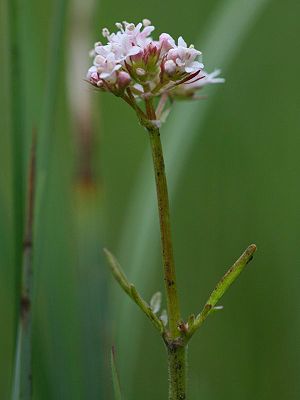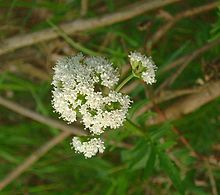Small valerian
| Small valerian | ||||||||||||
|---|---|---|---|---|---|---|---|---|---|---|---|---|

Male Small Valerian ( Valeriana dioica ) |
||||||||||||
| Systematics | ||||||||||||
|
||||||||||||
| Scientific name | ||||||||||||
| Valeriana dioica | ||||||||||||
| L. |
The dioecious Small valerian ( Valeriana dioica ), and marsh valerian or dioecious Valerian called, is a native plant species in Central Europe of the subfamily of the valerian plants (Valerianoideae).
features
The small valerian is a perennial plant with a rhizome and often forms slow-growing runners. This vegetative spread - which is also not uncommon in other species - can sometimes give the wrong impression that specimens of a certain sex dominate this species. Up to fifty female flower stems can stand together at one point. But they are connected to one another underground, so they form a clone and must therefore be of the same sex. The stems are erect and weakly branched at the top. The main axis is extended. The small valerian reaches heights of 10 to 35 centimeters.
The middle and upper stem leaves are pinnate with large terminal leaflets. The basal leaves are ovate, undivided and petiolate.
The flowers are in three-part, umbrella-shaped umbels . The small valerian is imperfectly dioecious, which means that there are usually purely male and purely female plants, but (rarely) hermaphrodites also occur. The female flowers (of the purely female plants) are only 1.5 mm in size and are whitish to light pink in color, while the male flowers (of the purely male plants) are about 3 mm in size and pink. Flowering time is May and June, pollination is carried out by insects.
The fruit is a single- compartment nut , the sterile compartments of which are reduced. The nut is radially symmetrical and ovoid.
The number of chromosomes is 2n = 16.
Occurrence
The species is native to Europe and western Asia. There are other occurrences in Central Asia and in North American Canada as well as in the northwestern USA. In Germany it occurs in all federal states, in some northern regions it is endangered. In Austria it is scattered to rare, occurs in all federal states, but is endangered in the flat regions.
It occurs in the colline to sub-alpine altitude and inhabits wet meadows, (rather calcareous) fens, swamps and swamp forests. In the Allgäu Alps, for example, it rises in the Ziebelmoos near the Piesenkopf to an altitude of 1340 meters. In terms of plant sociology, it is a weak species of the order Molinietalia caeruleae W. Koch 1926 and is mainly found in the associations Molinion caeruleae W. Koch 1926 and Calthion Tx. 1937. It thrives on waterlogged, seeping or alternately wet, more or less nutrient-rich and base-rich, moderately acidic to mild swamp humus soils.
The small valerian is fodder for the endangered valerian butterfly ( Melitaea diamina ).
Systematics
Valeriana dioica was 1753 by Linnaeus in Species Plantarum , Vol 1, page 31, first published . The clan native to North America is sometimes also listed as a separate variety Valeriana dioica var. Sylvatica S.Watson . Other synonyms for Valeriana dioica are Valeriana septentrionalis Rydb. , Valeriana sylvatica Banks ex Richardson and Valeriana dioica ssp. sylvatica ( S. Watson ) FGMey.
One can distinguish between two subspecies:
- Valeriana dioica L. subsp. dioica : It comes in Spain, Portugal, France, Great Britain, Italy, Germany, Belgium, in the Netherlands, Denmark, Norway, Sweden, in Switzerland, Austria, Czech Republic, Poland, Hungary, Slovenia, Bulgaria, Romania and in the European Turkey before.
- Valeriana dioica subsp. simplicifolia (Rchb.) Nyman : It occurs in the Czech Republic, Slovakia, Austria, Poland, Lithuania, Latvia, Estonia, Kaliningrad, Hungary, Romania, Bulgaria, European Turkey and the Ukraine.
swell
literature
- Manfred A. Fischer , Wolfgang Adler, Karl Oswald: Excursion flora for Austria, Liechtenstein and South Tyrol. 2nd, improved and enlarged edition. State of Upper Austria, Biology Center of the Upper Austrian State Museums, Linz 2005, ISBN 3-85474-140-5 .
- Siegmund Seybold (Ed.): Schmeil-Fitschen interactive (CD-Rom), Quelle & Meyer, Wiebelsheim 2001/2002, ISBN 3-494-01327-6
Individual evidence
- ↑ a b Valeriana dioica var. Sylvatica on USDA Plants Database
- ↑ Erhard Dörr, Wolfgang Lippert : Flora of the Allgäu and its surroundings. Volume 2, IHW, Eching 2004, ISBN 3-930167-61-1 , p. 538.
- ↑ a b Erich Oberdorfer : Plant-sociological excursion flora for Germany and neighboring areas . With the collaboration of Angelika Schwabe and Theo Müller. 8th, heavily revised and expanded edition. Eugen Ulmer, Stuttgart (Hohenheim) 2001, ISBN 3-8001-3131-5 , pp. 883 .
- ↑ Carl von Linné: Species Plantarum . tape 1 . Stockholm 1753, p. 31 ( First online publication of Valeriana dioica digitized at Biodiversity Heritage Library ).
- ^ GRIN Taxonomy for Plants. Taxon: Valeriana dioica. In: Germplasm Resources Information Network. United States Department of Agriculture - Agricultural Research Service, Beltsville Area, accessed April 13, 2012 .
- ^ A b c E. by Raab-Straube & T. Henning (2017+): Valerianaceae. - In: Euro + Med Plantbase - the information resource for Euro-Mediterranean plant diversity. Data sheet Valerianaceae
Web links
- Small valerian. In: FloraWeb.de.
- Small valerian . In: BiolFlor, the database of biological-ecological characteristics of the flora of Germany.
- Profile and distribution map for Bavaria . In: Botanical Information Hub of Bavaria .
- Primula integrifolia L. In: Info Flora , the national data and information center for Swiss flora . Retrieved April 1, 2016.
- Distribution map on Den virtuella floran
- Thomas Meyer: Valerian data sheet with identification key and photos at Flora-de: Flora von Deutschland (old name of the website: Flowers in Swabia )

